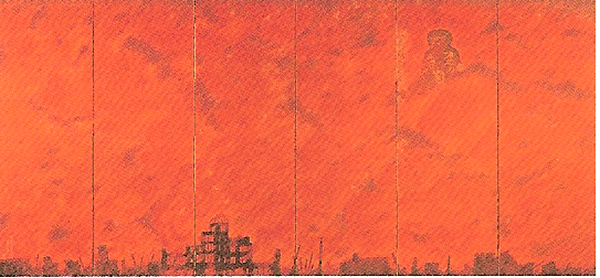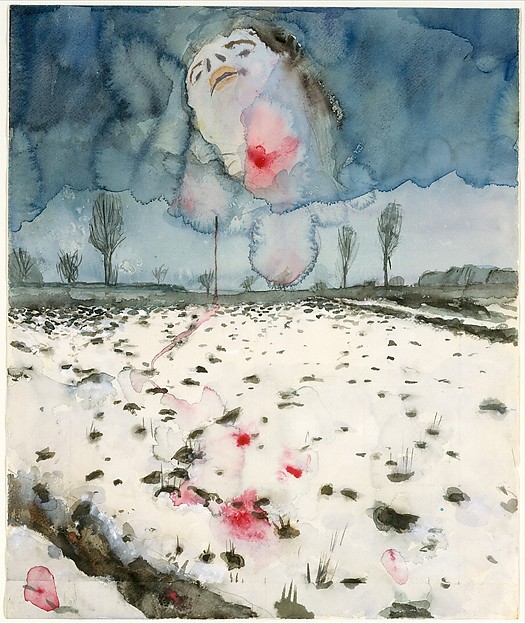Lucas Nelson
Introduction to art history
Creating Beauty in pain: Art as a tool for handling tragedy
Each and every individual will experience a tragic event at some point in their lives. It is an experience that, to some degree, is truly universal. This being said, tragedy is a broad word that can be tied to many different events.There events can range from losing a loved one, witnessing a horrendous action performed, to doing badly on a test, or a romantic break up. When faced with tragedy a person must choose how they react to it, do you turn and run? Do you face it head on? Or do you deny it? Each of these artists are responding to major tragedies that they bore witness to. In each of these works there is a wide varietyof views on tragedy and how to respond to it. Each of these works invokes different emotions in us and causes us to explore how we experience loss and tragedy ourselves. By viewing these artworks we can come to understand the nature of tragedy better and even explore our own tendencies in experiencing tragedy. This exhibit specifically deals with the topic of war and how it affected the artworks produced during these conflicts.
Winter Landscape
Anselm Kiefer
1970
Watercolor, gouache, and graphite on paper
17 x 14 1/8 in. (43.2 x 35.9 cm)
Held by the Metropolitan museum
Anselm Kiefer was a German born artist. His pieces are consistently focused on the events of the holocaust. The past actions of his native country deeply affected Kiefer and his pieces often showed a deep regret for the horrors of the war. This piece was made in response to world war two. The desolate landscape draws attention to the destruction caused by the war. The woman’s face in the middle is bleeding onto the ground, drawing attention to the loss of life that occurred on the ground.
The City: A Fallen Lift Shaft
Graham Sutherland
The City: A Fallen Lift Shaft
Graham Sutherland
1941
Gouache
44 x 26 in
Graham Sutherland was a well established artist by the beginning of World War Two and found his art heavily influenced by the events of the war. This painting shows the scene of a destroyed city, resembling the cities destroyed in the blitz. The dark colors on one half of the destroyed lift shaft give way into light on the other. This shows a subtle hopefulness even in the midst of rampant destruction. This painting shows a more hopeful view on the tragedy of the second world war.
Abbey in the Oakwood
Caspar David Friedrich
1809-1810
Oil on Canvas
110 x 171 cm
Held by Alte Nationalgalerie
Caspar David Friedrich was a prominent romantic artist. This piece shows the ruins of an abbey that appears in several of Friedrich’s works. This abbey was deconstructed during the thirty years war and the bricks were used for fortifications. In this work Friedrich draws a comparison between this abbey and the churches that were turned into barracks by invading French soldiers. Friedrich described this piece as a “funeral for the hope of Germany’s resurrection.” Friedrich sees war as a horrific act that ruins a countries chances at rebuilding. Friedrich paints a very hopeless picture for the future based on past tragedy.
Wandering Jew
Wandering Jew
Felix Nussbaum
1939
Oil on canvas
45 x 58 cm
Held by Kulturgeschichtliche Museum
Felix Nussbaum was a Jewish artist during the holocaust. This piece shows a lone figure wandering through an empty and desolate landscape. The painting gives the feeling of being lost and aimless. It also shows the figure as alone, with no help in sight. This work has often been seen as a call for help for the Jews during their persecution. Felix Nussbaum sees tragedy as a desolate landscape but also sees opportunity for improvement and help.
A dawn, 1914
Christopher Richard Wynne Nevinson
1916
Print on Paper
176 x 146 mm
Held by the British museum
Christopher Richard Wynne Nevinson made this print in 1916. It depicts French soldiers marching out of a city. This was made at a time when the war was falling out of general popularity. This print shows the faces of the French soldiers as they leave for war. They look melancholy as they leave the city, the colors show a sad and depressed mood. Nevinson is showing the more personal side of tragedy by giving a snapshot of soldiers who are struggling under the atrocities of war.
Holocaust of Hiroshima
Ikuo Hirayama
Ikuo Hirayama
Nihonga on canvas
6 panel work
Held by Hiroshima Prefectural art museum

Ikuo Hirayama was a survivor of the atomic bomb dropped on Hiroshima. In this painting you see a destroyed city in front of a blood red sky. In the background the Buddhist god of wrath looks down on the city. Hirayama said that the he saw the god of wrath as challenging the city to rebuild. The red of the sky evokes images of flames and gives the impression that the city could rise out of the ashes and rebuild. This pushes the idea of hardiness in the face of immense tragedy and persistence in recovery.





No comments:
Post a Comment